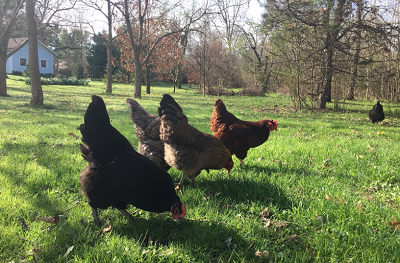Some of you may know that my husband and I keep chickens. They’ve been known to make a vocal appearance from time to time in the Fit Strong Women Over 50 podcast. They like to announce when they have just laid an egg – at least that is what I think they are saying!
I love the idea of farm fresh free range eggs.
What does that mean exactly? At our house, free range eggs means that the chicken run free, at least some of the time.
I will say, it is safer for chickens to stay in a pen. Ours are always penned in at night! When they are locked inside the pen, no hawks, owls, possums, raccoons, dogs and other predators are going to get them.
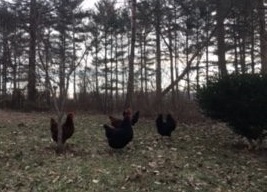
There isn’t a strong definition for free range. The idea is free range chickens eat bugs, worms and natural protein. I get a lot of questions about our chickens and will attempt to answer some of them here.
Some questions people like to ask me about the chickens:
- Do they have different colored shells and do those taste different?
- How many eggs to chickens lay?
- What’s the difference in the eggs?
- Do they only eat worms and bugs? what about when snow is all over the ground?
- How much free counts as free range?
- Why are store bought eggs better for hard boiled?
- Do you have a rooster?
When they are free ranging, we keep the coop door open so they can come and go as they please. It helps in gathering the eggs. If the chickens have a place to lay so we aren’t doing an Easter egg hunt every time we gather eggs. 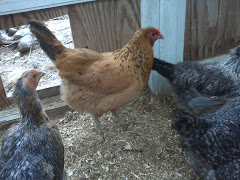
They lay just about every day when there is lot of sunshine and warmer temperatures. It seems like they lay only about once a week when there is little sunshine. Considering the cost of chicken food and all the equipment, it is so so much more economical to buy eggs at the grocery store.
Fair Weather Fowl
In the winter with snow covering the ground, they stay penned in and eat only the pellets and corn we provide to them. They are not interested in going out when it gets cold, windy, snowy or rainy.
Do they have different colored shells and do those taste different? Yes different breeds have different colored shells. Rhode Island red chickens have a reddish brown color shell. Leghorns, white. Americanas, greenish blue. 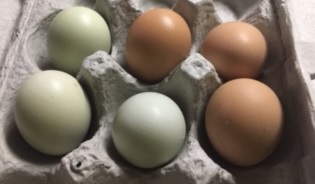
Although I’ve not noticed a difference in color or taste between the different breeds of chickens, I have noticed the color of the yoke is much richer on free range. And they taste much better too.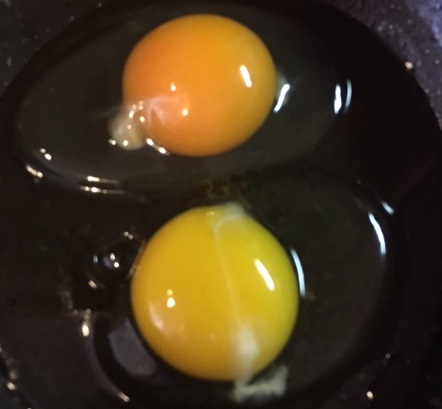 I’ve noticed that store bought eggs have a yellow to light yellow color yoke, but our chickens lay rich deep orange color yokes.
I’ve noticed that store bought eggs have a yellow to light yellow color yoke, but our chickens lay rich deep orange color yokes.
Taste: the yokes of the free range chickens taste much more full and creamy.
While on a nice sunny day, our chickens get to run around outside their cage, free range chickens are not without their challenges. Chickens can fly. Some people trim their wings.
Our chickens haven’t learned where the property line is. We have a split rail fence in the front of the house with a 3 foot flower bed with forsythia bushes, azelias, PJMs, burning bushes and Japanese iris. This helps to keep the chickens from going near the road. However our back yard is mostly open on the one side which tends to have the chickens wander over the the neighbors in search of greener pastures. The neighbor two doors away owns two mastiff dogs. Not aggressive dogs by any means, but obviously having chickens pecking around in their sight line but just over their invisible fence is not optimal by any means.
Our two dogs have been trained not to chase the chickens. The cats don’t seem very interested in them.
None the less, we try to keep the chickens interested in the land on our property by turning over the gardens on the close side of the house. They love taking dust baths in a dusty part under the overhang of our bay window.
Pecking Order
Sometimes the hens are feeling peckish, especially when they are bored. How much outside time do free range chickens need outside? Well, that is debatable. When they are penned up too much, they tend to resort to the Pecking Order. This means one poor hen is the bottom of the list. And usually the Queen Bee hen leads the picking and pecking on her. Nasty. They peck until it bleeds. Something about the color red makes them gang up on the lowest chicken. We had to send one of our Buff Orpington hens to another flock because she was so picked on. Now the other Buff Orpington is getting pecked, but not near as bad as her sister.
Sometimes free range is somewhat contained in a rolling or movable coop or fence. That doesn’t solve the pecking problem, but does give them some change in scenery and food.
Another difference that I’ve noticed between commercial eggs and our chicken’s eggs. There are much thinner shells on our chickens. Our chickens are about a year older than any commercial chicken. I’m sure that commercial eggs come from chickens that have been given something to increase the thickness of the shells. I’m sure this helps with travel. Especially since I’ve broken egg shells just walking the 150 feet up to the house from the coop. Pretty messy! I think you can feed them calcium to make their shells harder, but that’s just one more thing we’re buying and feeding to them.
I’ve heard you can crush the old eggshells to feed it back to the chickens to help their shells harden. We don’t want to get them used to the taste of egg shells as we’ve had problems with some of our chickens in the first flock pecking and eating their eggs.
No roosters.
In our first batch of chickens, the flock had two roosters. Crowing when it is still dark in the morning was annoying. Roosters attacking when I was trying to gather eggs was dangerous. They ate a lot and obviously did not provide any eggs. For the last two flocks we’ve had, we made sure to not get any roosters. When you buy chicks there are no guarantees of sex, but if you pay more the flock may have an 80-90% chance of hens. Not sure how they can tell the difference until the chickens are older. We bought ours three years ago as peeps when they were just 2 days hatched.
While I usually enjoy the chickens, it is work. You’ve got to live somewhere that allows chickens. Don’t try to figure the cost per dozen eggs or you’ll be sad.
If you want farm fresh, free range eggs, be willing to spend about $3 or $3.50 a dozen from a farmer’s market. You’ll still be getting a bargain!
